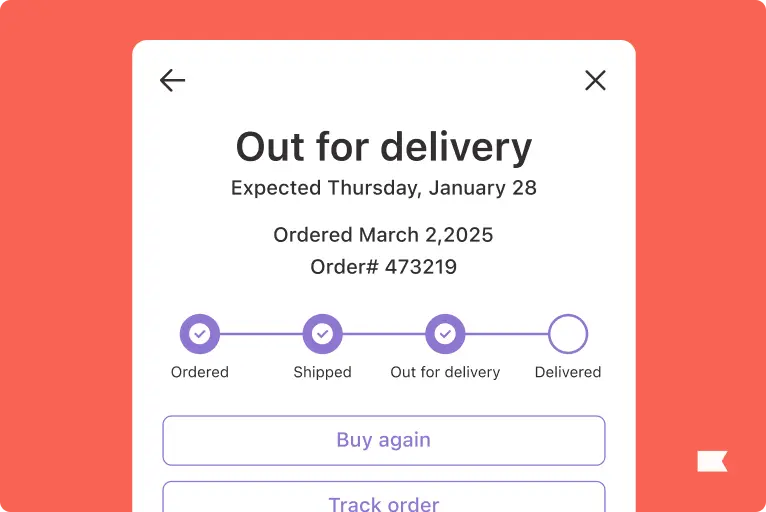
How to market with a small product line
What do Crocs, Spanx, and Michelin all have in common?
They were all built on a single product. Crocs started with one style of waterproof boat shoe. Sara Blakely founded Spanx after creating a single slip-on undergarment. Michelin began with a tyre.
But while these brands have gone on to expand their product lines, many brands don’t. Some permanently keep a cosy catalogue of products. For others, it’s less of a choice and more of a needs-must. Newer brands often don’t have the collateral to invest in huge product catalogues. Instead, they have to make do with what they have.
It might seem easier to market a smaller product line—after all, you don’t have to create hundreds of campaigns for hundreds of products. But, like with anything, there are limitations and challenges.
The challenge of marketing small product lines
Smaller product lines often demand more creativity in the marketing department, simply because there’s a limited number of ways you can present a limited number of products.
Here are some common challenges for brands with small product collections.
Narrow appeal
Take Crocs, as an example. Aside from the fact the brand sells a Marmite product (you either love them or you hate them), there’s no denying they were targeting a very slim segment of the market with their original design.
Today, they have plenty of styles and variations to suit a host of different tastes, but to start with it was far more limited. This narrow appeal can make it hard to, firstly, find the right segment of the market and, secondly, market the product to them in a way that resonates.
Now, you could come at this with a lens of “Surely it’s easier to market to a very defined target audience?”. And, yes, there are pros to this. Having a very narrow market often means you can hone in on those people’s tastes, desires, wants, and preferences. But the downside is, there’s a potential ceiling to sales. Only so many people are going to want a unique waterproof boat shoe in black, red, or blue.
For many brands with small product lines, the challenge is branching out to different markets and presenting their product in a way that appeals to people outside their initial target audience.
Repetition
There’s a lot of talk about the “rule of seven” in marketing, where prospects need to see a brand, ad, or product seven times before they commit to buying. But while there’s a certain amount of repetition involved in marketing, it can be challenging to brainstorm novel ideas for campaigns about the same products.
If you’ve only got a handful of products in your collection, chances are you’ll inevitably circle through the benefits, features, and reviews quickly and have to start again from the beginning.
To keep things fresh, brands consistently have to come up with new ideas, new angles, and new ways to promote old products.
Cross-selling
It’s hard to cross-sell when you have a limited product line. Often, cross-selling involves showcasing similar products or using shopper preferences to strategically deliver relevant product recommendations. Both of these are difficult if your product line is limited to one type of product or if there’s not a lot of variation to align with customer preferences.
It’s still possible, you just have to think outside the box. For example, Lucas’ Paw Paw Remedies has a very limited product line but it still manages to cross-sell products at checkout. Instead of suggesting relevant products, it suggests bulk orders and gift packs that are more expensive but can work out better value for customers.
Cost efficiency
Obviously, the more products you have, the more chances you have to sell.
Brands with smaller product lines tend to struggle more with cost efficiency because they can’t count on sales spread across numerous SKUs. Instead, they’re relying on continuous sales from a handful of products, which can fluctuate throughout the year.
On top of this, it can be more expensive to manufacture a smaller number of products because you can’t lock in juicy bulk discounts. This means brands with smaller product lines often have to charge more for their products and create an exclusive sentiment to warrant the higher price tag.
Leaning into your brand story: take confidence in who you’re for and who you’re not for
The most important thing brands with limited product lines can do is find their position in the market. This means having a transparent, unwavering understanding of who you serve and who you don’t serve. Creating this exclusive club vibe can generate a buzz around your brand (and products) which can lead to more customers and more sales.
Take Kiini, for example. The swimwear brand sells three different products in varying colours. Through its social media marketing, it conveys a sense of luxury and exclusivity with beautifully whimsical photos and a heavy emphasis on user-generated content (UGC).
The brand encourages its circle of loyal customers to share their Kiini experiences using the hashtag #kiinispirit. This creates a sense of FOMO, but it also shows Kiini’s complete confidence in knowing exactly who it is and who it serves.
Kiini hasn’t made any attempt to expand its product line. Instead, it expands its reach by partnering with celebrities and getting placements in big-name magazines and style guides.
It’s a similar story to Le Creuset, which is famous for its colourful enamel cookware. Over the years, the brand has added various new colours to its collection but hasn’t expanded much beyond its basic cookware range and it continues to maintain a small product line.
For Le Creuset, it’s all about creating an exclusive, premium feel. It markets to an audience who loves to host, cook, and entertain—three things it regularly calls out in its social media posts.
Source: https://www.instagram.com/p/C7E3G_sIrCK/
Le Creuset has positioned itself so well that people expect to pay a premium price tag for its products (and are happy to do so). It’s almost created a “club” of cookware fans by targeting a specific set of home cooks who value the luxury things in life.
How to keep your audience engaged
Consumers today are constantly having their attention spans plagued by an army of brand discounts and new product releases. This presents a problem for brands with small product lines: engaging short attention spans. Shoppers like new things and, with a constantly expanding product line, there’s always something new to tempt potential customers.
But with a small catalogue, it’s much harder to keep shoppers engaged and stop them from going elsewhere. Here are some tips to maintain high engagement levels when you’re not releasing a new product every week.
Use automation to improve cost efficiency
Working with a smaller range of products can be beneficial in many ways—not least because you can really focus on making a handful of products amazing. But the hard part is balancing the high costs of manufacturing and marketing across a potentially smaller pool of sales. To improve cost efficiency, look at automating core parts of the sales process so you can focus on growing your reach elsewhere and entering new markets.
For example, once you sell a product, you can automate:
- Personalised product recommendation emails to introduce customers to other products in your line.
- Replenishment reminder emails to ensure customers don’t run out of the product.
- Rewards by sending loyal customers a discount they can use on their next purchase.
These are all quick and easy ways to win new customers from existing shoppers, increasing customer lifetime value (LTV) and boosting loyalty.
Offer subscription services to automate repeat business
UK toilet paper brand, Who Gives a Crap, sells just one thing: toilet paper. But to win customer affection and ensure it has a rolling recurring revenue, it offers subscription services—the last thing customers want is to be caught short without loo roll to hand.
The environmentally-friendly brand leans hard into subscriptions, offering steep discounts for customers who choose to invest on a rolling basis.
Subscriptions work best for consumable products, such as beauty creams, makeup, coffee, food, and essentials (like toilet rolls). But there’s no reason you can’t create subscription services around other products. Take Socks in a Box, for example, which delivers a fresh box of socks to subscribers every month.
Build strong individual customer relationships
Customers are the lifeblood of any ecommerce business, particularly for brands with smaller product lines because they’re the people most likely to recommend you to their friends and family.
Building strong individual customer relationships is a great way to win favour with existing customers and ensure they come back again and again. Water brand, La Croix, regularly re-post content from their customers on social media to show their appreciation (plus it’s a great way to get fresh, additional content for your campaigns).
Source: https://www.instagram.com/p/C6PFRqssabz/
Come up with creative marketing strategies
Marketing the same few products again and again can feel relentless. This is why it’s important for brands with smaller product lines to get creative with their campaigns—think outside the box and use strategies that don’t necessarily put the product front and centre.
Let’s use Who Gives a Crap as an example again. The brand has a successful Instagram account where it shares fun memes, relevant questions, and content that’s not directly tied to toilet roll.
Source: https://www.instagram.com/p/C62F3JGyGMa/?img_index=1
It follows a similar theme on TikTok where it jumps on trending events and topics and shares something loosely related to the bathroom or toilet roll.
Source: https://www.tiktok.com/@whogivesacraptp/photo/7366125784563485998?lang=en
Always be innovating
Brands with smaller product lines are constantly competing with companies that have hundreds, thousands, and even millions of SKUs.
To retain customer attention, you need to keep things fresh and on-trend. Even traditional brands like Le Creuset update their products to align with current consumer trends—the brand recently launched a peach version of its classic casserole dish to tie in with this season’s spring colours.
Innovation isn’t just about ensuring your products are aligned with the current market. It’s also about ensuring your marketing and sales strategies use modern tactics and tools. Automation can save a lot of time, allowing you to generate sales on autopilot while you improve your products in the background.
As a brand with limited products, you’re under more pressure to promote why customers should buy from you and not a mega-marketplace with tons of choices. To keep customers onside (and keep Shiny Object Syndrome at bay), make sure you’re flexible enough to pivot and meet fast-changing trends.
Good things come in small packages
Whatever the reason behind your smaller-than-average product line, you have choices. Cosy collections often have an exclusive, premium feel to them, but they also give you the chance to get to know your customers and understand why they buy from you.
While there are plenty of challenges that come with a smaller product line, it presents the perfect opportunity for you to flex your creative muscles. Marketing looks slightly different for brands with fewer products because you can’t lean on new launches all the time. Instead, you need to dig deep into who your customers are, where your position is in the market, and how you can use tools and strategies to generate recurring revenue.

Related content

Acquisition is harder and ads cost more—so how do smart brands keep growing? Learn how customer value optimisation (CVO) helps you turn first-time buyers into loyal, high-value customers.

With rising acquisition costs, customer retention is more crucial than ever. Discover 8 strategies from Klaviyo to boost ROI and keep customers loyal.

Discover Klaviyo’s ultimate guide to discounting pricing strategies for Black Friday.